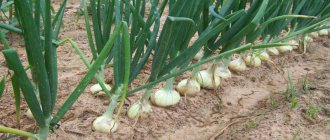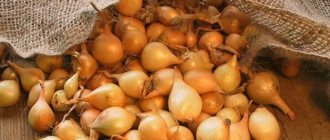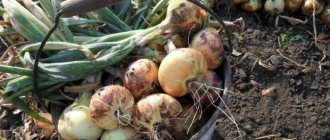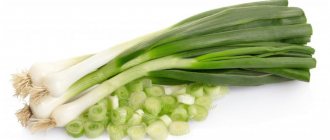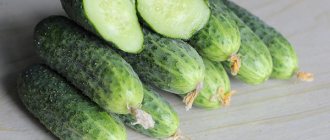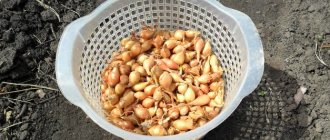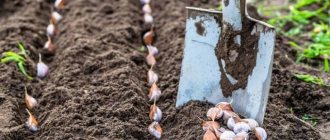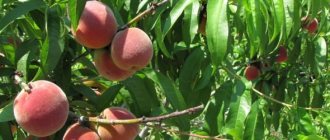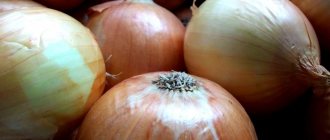There are many frost-resistant varieties of onions. This type of onion is also called winter onion. There are a number of advantages in favor of planting it in the fall before winter. However, there are certain rules for planting and protecting onions from frost to obtain the maximum amount of harvest.
It is important to know how to plant onions, what is the most favorable period for this, and what variety to choose for a particular region.
Is it possible to plant Dutch onions before winter?
Dutch acute and semi-acute varieties are excellent for planting before winter throughout Russia . They practically do not bolt, are frost-resistant and can withstand soil temperatures down to -15°C.
At lower temperatures, thick snow cover can protect them. However, you should not plant southern sweet onion varieties before winter - they will not tolerate cold weather.
When to plant winter onions
Focus on the climate norms of the region . Plant onions when the daytime temperature drops to +5...+7°C and stays at this level for at least a week.
When planted in winter, it takes three weeks for sets to take root. If the onion does not have time to take root before the onset of frost, it will either not sprout in the spring or will go to pieces.
Advantages and disadvantages of winter varieties
Not all varieties of onions are suitable for planting before winter. A set that takes root slowly will not survive in cold winter soil. Most of the crops will die, and the sprouted onions will go to waste in the spring.
Breeders have developed special winter varieties that are resistant to long periods of frosty weather and actively form heads during short daylight hours.
Advantages of winter onion varieties:
- planting onions before winter saves the gardener from problems with storing planting material; in the fall, small sets are planted, which are not able to last until spring;
- the opportunity to get a harvest 2-3 weeks earlier than when planting using spring technology;
- winter onion sets have a high germination rate;
- plants form a powerful root system that can actively absorb nutrients from the soil;
- are able to successfully vegetate under short daylight conditions (12-14 hours);
- require less maintenance (weeding, watering);
- little susceptible to major onion diseases and insect pests;
- healthy root vegetables last a long time.
Disadvantages of winter hybrids: slightly more planting material is required (the weakest and damaged seeds will freeze in winter), lower yield compared to spring varieties.
Varieties of Dutch selection
There are more than two dozen winter varieties from Holland on the Russian market . Let us list those that have proven themselves to be excellent during winter planting in various regions of Russia and are therefore most popular among summer residents.
Radar
An early ripening hybrid, zoned throughout the Russian Federation . It tolerates temperatures down to -15°C, with large amounts of snow it can withstand temperatures down to -25°C, and is resistant to bolting. The bulb is golden yellow in color, round in shape, high density.
Large - with good care it grows weighing up to 150-300 g. The harvest is perfectly stored. Radar is highly resistant to diseases and pests. When planted in winter, the heads grow by the beginning of June.
Bow Radar
Shakespeare
This is one of the most reliable semi-sharp winter varieties . Shakespeare tolerates temperatures down to -18°C even without snow cover.
Early ripening - 75 days pass from germination to ripening. The color of the scales is brown. The flesh of the bulbs is white and juicy. The heads are round in shape, weighing about 100 g. The variety is resistant to diseases.
Bow Shakespeare
Centurion
The early ripening hybrid has a moderately spicy taste . The shape of the bulbs is slightly elongated, the flesh is white, the husk is golden yellow. The head grows weighing from 100 to 150 g.
Centurion is an improved version of the popular German variety Stuttgarten Riesen. Valued for its resistance to excess humidity, dry weather, and large temperature changes. This variety is grown in all regions of Russia, from the south to the Far East. At low temperatures, the crop is stored for 8 months.
Bow Centurion
Hercules
High-yielding hybrid Hercules of early ripening . The heads weigh 120-160 g and reach maturity 70-80 days after the start of the growing season. The bulbs are oval-oblong, golden yellow in color. The pulp is juicy, white; the taste is spicy. Advantages: undemanding to soil, frost resistance, excellent keeping quality. It can be stored for up to 9-10 months.
The variety has high immunity to many diseases and viruses. It is recommended for cultivation in the central part of Russia, but due to its unpretentiousness it is planted almost everywhere.
Bow Hercules
Sturon
The mid-season onion variety ripens in 110-120 days, is resistant to bolting, and is cold-resistant . Very productive - distinguished by large bulbs up to 180-210 g. They have an ellipsoidal shape, the husk is golden in color. The onion is dense and juicy. Can be stored for up to 9 months. Resistant to diseases, does not form an arrow.
Sturon is recommended for cultivation in temperate and southern latitudes. The variety is popular in many areas. The Central and West Siberian regions are considered favorable in terms of climate and soil.
Bow Sturon
Troy
Undemanding early ripening hybrid . The harvest is obtained 75-80 days after the feather appears. Onion with a pungent taste, white flesh. Tolerates frosts well and does not bolt. The heads are round, with a dense golden husk. Troy has high keeping quality. It has good immunity - resistant to diseases and pests.
Bow Troy
Important! Choose varieties for planting based on daylight hours. In short summers, give preference to early varieties with a minimum period of bulb ripening.
For different regions
Breeders have developed varieties adapted to the conditions of all parts of the country in which vegetable crops are grown.
For each region there are zoned species. When choosing the variety most suitable for a given region, the characteristics of weather conditions, moisture, and temperature changes are taken into account.
For Siberia
Traditionally, domestic Strigunovsky was grown here. Now - varieties of Dutch selection:
- Early winter - Siberia F1, a Dutch hybrid, with a ripening period of 250–260 days and high winter hardiness. The bulb is juicy, white, tasty with a strong brown husk, which ensures its storage in winter.
- An early variety for spring planting as seedlings is Centurion.
- Mid-early Hercules F1, with strong roots, drought-resistant. Bulbs weighing up to 130 grams, with a dry, dense husk that preserves it in winter.
- Mid-season Red Baron.
- Late - Sturron.
For central Russia
- Early ones - Centurion, Carmen.
- Mid-early Hercules F1.
- Mid-season Red Baron.
- Late Sturron, Setton.
For the south of Russia
- Exhibition from seeds.
- Carmen.
- Red Carmen.
Sweet salad varieties grow well in the south. High-yielding, but with a short shelf life.
Onions of Dutch selection have a variety of tastes, are characterized by high yields, and are resistant to diseases and most pests. Almost no effect on the shooter. Many varieties keep well. The ability to buy ready-made planting material makes the gardener’s work easier. If desired, you can plant varieties that grow from seeds in one season.
If you find an error, please select a piece of text and press Ctrl+Enter.
Preparation
Before planting winter seedlings, carefully prepare the soil and seed .
beds
Choose a location for the garden bed. A well-ventilated area where snow melts early in the spring and water does not stagnate is best . Onions love loose, fertile soil with a neutral acid-base balance.
Dig up the soil with humus (5-6 kg per 1 sq. m) or mineral potassium-phosphorus fertilizers (30 g per 1 sq. m) and urea (6-12 g per 1 sq. m). Do not add unrotted manure to the ground when planting onions.
Form beds 20-40 cm high to avoid excessive moisture.
Planting material
Calibrate the seed material. Wild oats with a diameter of up to 1 cm are only suitable for growing bulbs . Place 1 to 2 cm in size on the feather and head.
Check each onion for damage, rot, and bacterial infections. The set should be dry, without spots on the husk.
Carry out disinfection. Soak for no more than 5 minutes in a warm (+45°C) solution of copper sulfate (1 teaspoon per 1 liter of water) or potassium permanganate (10 g per 1 liter of water). Dry the planting material well for 12-24 hours.
Important! When planting in winter, do not cut off the necks of the sets. Plant it dry, without germination.
Landing technology
It is important to sow crops before winter at the right time. The seeds should not have time to germinate before the onset of cold weather, but they need to take root. Typically, sets are planted in open ground at the same time as winter garlic, 3-4 weeks before the onset of frost. The soil temperature at this time drops to +5..+6 degrees, the average daily temperature is at +8 degrees.
Approximate planting dates for winter onion sets, by region:
- in the middle zone and Moscow region - in October;
- in the south of the country - at the end of October or the first half of November;
- in the northern regions, in the Urals and Siberia - in September.
Important! It is allowed to sow nigella onions at very late dates, already on frozen ground. The seeds are more cold-resistant than onions.
Planting onion sets before winter
The technology for growing winter onions includes preparing the soil and sowing itself. For the onion bed, choose a flat area open to the sun. It should not be flooded with melt water or become swampy in the spring.
The soil for onions should be fertile and loose. A good substrate consists of a mixture of humus, garden soil, sand and peat. As fertilizer, 5-6 kg of rotted manure and 2 cups of wood ash are applied to each meter of plot. Organics can be replaced with complex mineral fertilizers for onions and garlic. It is better to use granules that gradually dissolve in the soil. By spring, they will completely disintegrate into individual elements accessible to plants.
Sorted planting material
Winter onions do not need to be soaked or germinated before planting. It is planted dry after standard calibration. Which seedlings are selected for sowing:
- the size of the bulbs ranges from 8 mm to 20 mm in diameter;
- the head is dense to the touch;
- the peel is shiny and dry;
- There are no signs of rot on the sets.
On a note! Large onions (selections), with a diameter of more than 25 mm, can also be planted in a separate bed before winter. In early spring, early juicy greens for salads are obtained from it.
Description of work.
- Furrows 10 cm deep are marked on the prepared area. The distance between them is 25 cm.
- Clean, dry sand is poured into the bottom of the furrows in a layer of 2 cm. It will serve as drainage when the snow melts in the spring and the soil becomes waterlogged.
- The seedlings are placed in rows denser than during spring sowing, every 5 cm. The winter loss of planting material is taken into account. If the onions sprout too thickly in the spring, the excess plants are pulled out “for greenery.”
- The rows are covered with dry fertile soil (a mixture of peat and humus).
How to plant Dutch onions for the winter
To achieve good germination of seed in the spring and get an excellent onion harvest, follow the following rules.
Prepare material in advance to cover the beds for the winter. For example, non-woven fabric (lutrasil, spunbond), sawdust or straw, spruce branches. The latter retain large amounts of snow on the soil.
Step-by-step instruction:
- Level and compact the soil in the beds.
- Mark the rows for planting, leaving a gap of 20-25 cm between them.
- Make indentations for the bulbs in the grooves at the optimal distance from each other.
- Plant the seed so that it is buried 5 cm into the soil. Sprinkle it with dry soil or peat on top. There is no need to water onions when growing them in winter.
- When the first frost occurs, cover the plantings with mulch or other prepared material.
Before the onset of frost, do not cover the beds with winter onions with covering material - there is a risk of damping off.
Landing schemes
The gardener determines the planting scheme for seedlings himself, focusing on the geometric dimensions of the beds.
Usually a tape scheme is used. There is a gap of 20-25 cm between the rows, and 5-10 cm between the onions in the rows, depending on the varietal characteristics of the mature onion head, as well as on the size of the set. Oatmeal is planted every 5-6 cm, seedlings - every 7-10 cm. Planting depth for the winter is 5 cm from the neck of the bulb to the soil surface.
Nest planting is also practiced. 3-4 bulbs are placed in one hole at a distance of 10 cm from each other.
How to care for a winter garden
Experienced gardeners know that the work is not limited to planting seedlings - it is necessary to prepare for the arrival of real winter.
- To protect plantings from frost, use traditional mulch. The most popular option is dry leaves, which are abundant in any summer cottage.
- To prevent the leaves from being blown away by the wind, large branches left over from pruning the garden are placed on top of them. This material also promotes snow retention.
- With equal success, the beds can be covered with reeds, spruce branches and other plants.
Practice shows that a layer of snow 20 cm thick reliably protects all winter crops from frost of −25…-30 °C.
In the video you can learn useful tips on planting onions before winter so that their feathers are on the table all year round.
What mistakes should you avoid?
When growing Dutch onions, consider the following nuances::
- Planting too early will lead to the emergence of seedlings and subsequent death of the onion from winter cold.
- Do not plant seedlings in a newly prepared bed. Allow the soil to settle for 2-3 weeks (less in rainy weather). Planting material in loose soil may become too deep, and seedlings will not appear in the spring for a long time.
- If you plant the seedlings shallowly, the bulbs will die from frost in winter.
- Don't forget to cover the bed with the planted onions for the winter. If there is little snow, this will help avoid freezing of the seed.
- In case of a winter with little snow or severe frosts, cover the beds with snow for additional protection.
Common mistakes when landing
Errors in agricultural technology for winter planting are quite common. The main mistake most often occurs through no fault of the gardener: the weather has changed, and warming has caused growth processes.
In most cases, the appearance of green shoots does not lead to the death of the plantings. If a zoned onion variety is planted, the plants will overwinter successfully. Remember how wild forms of onion plants - wild garlic, bear's onion and others - overwinter without any artificial tricks.
Planting an unsuitable variety usually results in sparse seedlings in the spring—some of the planting material dies.
A bed of winter onions, even of a local variety, will not survive the winter if sets or nigella seeds are planted in a damp, flooded place.
Further care
In the spring, after the snow melts and the onset of warm days without frost, the covering material is removed, and the mulch is also removed from the garden bed. If this is not done, the ground will take a long time to thaw and the growth of the onion will slow down.
When seedlings appear, the soil is loosened. To avoid excessive moisture in the soil and saturate it with oxygen, sprinkle it with ash.
Subsequently, fertilizing is carried out with solutions of organic (chicken manure, mullein) or mineral fertilizers, and they are regularly weeded and loosened.
How to properly trim and dry
If the onion roots are located in the upper part of the soil, then you can simply pull out the plants. If difficulties arise, use a pitchfork or shovel. The harvested crop must be dried. To dry, the bulbs are laid out on a flat, ventilated place under a canopy. Periodically turn the bulbs over to provide air access. After three days, the feathers dry out and then you can remove the dried feathers and roots. Feathers can be removed by hand or trimmed with scissors, leaving a length of 4 cm. The roots are trimmed carefully, trying not to damage the bottom of the bulb.
Recently, the “old grandmother’s method” has begun to be used for storage in an apartment or house. It does not require trimming the feathers; the remaining dried feathers are woven into a braid and hung on the wall in a convenient place. This method allows you to save space in your apartment or house, as well as energy.
Features of planting and growing depending on the region
All of the above varieties of Dutch selection are suitable for winter cultivation in any climatic regions of Russia.
The difference lies in the timing of winter planting, which is determined by the period of frost:
- Ural winters are cold and snowy , so frost-resistant early varieties are used for cultivation. Planting takes place at the end of September or beginning of October.
- In Siberia, winter onions are planted during September . Select a frost-resistant variety and carefully cover the beds for the winter.
- Gardeners in the northwestern regions usually begin planting winter onions in the first ten days of October.
- In the central part of Russia - from September 20 to October 20.
- In the southern regions, the favorable period is from late October to late November.
Harvesting and storage
With the onset of September, onions are harvested in the southern zones in the first half of the month. In colder climates, harvesting occurs later. The main signs of maturity are fallen foliage and golden dried scales. There is no point in delaying harvesting; the bulb may awaken and begin to grow. After digging up the fruits, it is necessary to dry them well and remove the scales that have peeled off from the turnips.
Roots and feathers are trimmed. Onions are dried in one layer. If weather conditions permit, drying is carried out outdoors. If you need to dry indoors, make sure it is bright and ventilated. After three weeks, the fruits can be moved to storage.
Typically, onions are stored at home in:
Regardless of the variety, onions should be stored in a cool, dry place at low temperatures. Semi-sharp and sweet varieties have an average shelf life. Rapidly ripening and sharp bulbs are subject to long-term storage. The heads should be firm and dry. The spicier the variety, the lower the storage temperature should be, optimally -3°C. Store semi-sweet and sweet varieties at 0°C. Onions should not be on a heap; keep large heads separate from small ones.
Onion sets of Dutch selection can be grown in a wide variety of climatic regions. The most correctly selected variety for your region will allow you to grow and harvest a good harvest without much effort. By adhering to just a few rules for its care and storage, every gardener will provide himself with a supply of vegetables until the next harvest season.
Advice from experienced summer residents
To reap a rich harvest of Dutch onions, follow the advice of experienced gardeners:
- If you feel that you don’t have time to plant onions, and according to the forecast frosts will come soon, postpone planting until the spring. There is a high risk that onions that have not taken root in time will freeze in winter and you will lose your entire harvest. You can only plant wild wild oats, which are poorly stored, unlike sets.
- Plant a selection between the rows of seedlings. In the spring it will produce good feathers and you will get early green onions.
- Sometimes gardeners forget what crops they grew in their garden beds in previous years. And this is important for organizing competent crop rotation. Keep a gardening diary. Draw a site plan and mark by year on which plots of land this or that crop was grown. Write down what fertilizing was done; Comment on what plant diseases or pests you have encountered.
Variety Radar
Unlike Shakespeare, another promising winter variety, Radar, has a medium ripening period. Its popularity is explained primarily by the excellent taste of the bulbs and their very good keeping quality. The color of the scales of this variety is light yellow. Another distinctive feature is the large size of the heads. Grow bulbs in 150 gr. it won't be difficult. In some years, with careful care, the heads of the Radar variety can reach 300 g in weight. Radar's winter onion harvest is more than good.
Growing
Do you need to determine for what purpose you need to grow onions - for green feathers or turnips? If to obtain a feather, then the seeds are sown often, and to obtain a bulb, the distance between the seeds should be 1 - 1.5 centimeters. Otherwise the bulbs will grow small.
When seeds germinate, seedlings must be thinned out, otherwise it is impossible to obtain large bulbs. For ease of sowing, the seeds are powdered with chalk - they are easily separated from each other and become clearly visible on the ground.
So, they begin to grow onions in this way: early in the spring, they sow the seeds of the varieties of interest and collect small onions in August. They are dried and stored until spring. Next spring, these onion sets are planted again and in the fall they get a full-fledged turnip onion.
For planting, the best size for bulbs is 2 centimeters in diameter. Dry and damaged bulbs are discarded. Small bulbs can be planted before winter, because they can dry out during storage. If planting is done in the spring, then small bulbs are planted first, then medium ones, and lastly large ones. Large bulbs go into arrow faster. If the onion has gone into arrows, then even after its removal the onion will not be able to become a marketable turnip. These onions are primarily used for cooking. It is better to plant onions in warm soil, after digging it up and removing any remaining weeds from it.
Plant the sets at a distance of 10 centimeters, leaving 25 centimeters between the rows. The bulb is placed in the ground so that the tail remains on the surface. In the future, plantings need to be loosened regularly, not only after each rain, but more often. Onions love regular watering, but it is important not to overdo it. Most of all, onions need watering at the beginning, during seed germination, formation of the root system and growth of green mass. In the future, watering is also needed, but it should not be so abundant and frequent. And about a month before harvesting, the onions are no longer watered. You should also pay attention to feeding. To do this, use a solution of mullein.
